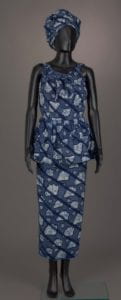This online blog post features materials protected by the Fair Use guidelines of Section 107 of the US Copyright Act. All rights reserved to the copyright owners.
Blog post by Aicha Diaby

Figure 1. Textile, Dutch wax print of independence material, with a map of Nigeria and the six-pointed star, small piece. CF+TC Accession Number 2015.02.020
I recently visited the Cornell Fashion + Textile Collection (CF+TC) and found a beautiful blue and white Nigerian wax print fabric with a map and star pattern (Accession Number 2015.02.020) (see Figure 1), which became a popular design around the time Nigeria gained its independence on October 1, 1960. According to Akinwumi (2008), “the early years of the twentieth century witnessed the export of predominantly blue prints for Nigeria” (p. 183), which is depicted in figures 2, 3, 4, and 6. The fabric in the CF+TC is a part of the Paul and Doris Ward Collection of Nigerian textiles which the Ward’s acquired during multiple trips to Nigeria between 1958 and 1963. The textiles were used to create both men and women’s garments, as shown in figures 2, 3, and 4. In the design of the fabric in the CF+TC, you can see elements of point and line as well as principles of design such as proportion and balance. The design makes use of lines on a diagonal, giving the illusion of movement. This is strongly depicted in figure 4 due to the form of the piece. The diagonal line allows the piece to move with the body compared to if there were no lines. The use of proportion can be seen by the different size maps of Nigeria and the stars on the fabric. These patterns are also moving on a diagonal and due to their difference in size, it gives the illusion of a wave or ripple. Overall, the design of the fabric has an asymmetrical informal balance.

Figure 2. Woman’s skirt of Dutch wax print depicting a map of Nigeria and six-pointed stars gathered skirt with waistband. CF+TC Accession Number 2015.02.057

Figure 3. Woman’s blouse made from Dutch wax independence cotton cloth depicting a map of Nigeria and six-pointed stars. CF+TC Accession Number 2015.02.058
Personal Reflections on Wax Print Fabric
Growing up in a West African household, I was always surrounded by beautiful textiles with intricate designs. I have a fond collection of memories from the ages of 5 to 9 tagging along with my mother as she would go to a local woman’s house to buy African wax print fabric. These wax prints were imported from Ivory Coast. Every time we visited, the woman would show us the latest and most popular designs in the Ivory Coast at the time. I remember the price for 6 yards of these wax print fabrics typically ranged between $100-$250. Now that I am older and I do my own shopping for African wax print fabric, the amount I spend on fabric ranges from $20-$40 for 6 yards. You may be wondering why there is a significant difference between what my mom would pay versus what I currently pay. To address this question, this short essay will speak to the history of African wax print and explain the problems it is facing today.

Figure 4. Figure 4: Man’s three-piece outfit in Independence cloth, with a map of Nigeria and six-pointed star. CF+TC Accession Number 2015.02.074abc
According to Akinwumi (2008), “African wax print was developed from batik, the latter being of Indian origin” (p.181). In the course FSAD 1250: Fashion, Art, and Design Thinking we learned about and discussed the batik method, a type of resist printing process where wax is applied to certain areas of the fabric, as seen in Figure 5. After the wax hardens, the fabric is dyed and then boiled to remove the wax, which creates a “cracked glass” look. African wax print designs often feature images of animals, different objects, and geometric patterns. Some of these designs have meanings behind them, which is related to batik being of Hindu origin. Authors have noted that because of batik’s Hindu origin, it’s “sacred importance is associated with women’s birth, initiation, marriage, and death” (Akinwumi, 2008, p. 181; Lindholm, 1979, p.32; Lubell,1976, p. 178).
Batik was particularly a medium for depicting symbols of Javanese women’s fertility such as crowned snakes, whereas among the Sawu in Sunda island of Indonesia, the cloth was used as a means of clan identification (Akinwumi, 2008, p. 181; Newman, 1977, p.20). In African wax prints today the use of a geometric design is most common. In the article “A Review of Symbolism in Indigenous West African Textiles”, Ulzen-Appiah states “West African textile artists seem to favor a more improvised, fluid effect that plays with deliberate asymmetries and pattern variation” (Ulzen-Appiah, 2005, p.108). The use of geometric patterns was greatly developed due to “the short period Java was made an Islamic state, because Islam forbade the representation of human forms and anything alike” (Akinwumi, 2008, p. 181).

Figure 5. Picture of someone using a canting to make a hand drawn batik, known as Tulis Batiks. Indonesian Batiks Blog, https://indobatiks.com/info/batik-process-and-care/
It is very ironic that the African wax print is called African wax print, being that it was “originally forged by Dutch colonial companies attempting to mechanically reproduce handmade Javanese batik cloth” (Sylvanus, 2016, para 2). Wax prints were largely introduced to Africa in the late nineteenth century by the Dutch due to a lack of popularity for wax prints in Europe and Southeast Asia. More specifically, wax prints were introduced to and exchanged within West and Central Africa through, for example, Christian missionaries who utilized the prints for converts, European producers who made wax prints for the African market, and West African soldiers who brought back Javanese batiks to their wives after serving between 1810 and 1862 in Indonesia (Akinwumi, 2008, p. 182). As these exchanges increased, wax prints gained more popularity in West Africa. Successful designs were given “indigenous names in form of proverbs, catch phrases, catch words, slogans, maxims and puns” (Akinwumi, 2008, p. 182) as a way to market the fabrics. As stated prior, African wax prints were not originally developed in Africa, therefore their designs are influenced by artistic and aesthetic elements from Indonesian, Indian, Chinese, Arab, Dutch, and European cultures.
In my anecdote above I stated how in comparison to the African wax print my mom buys, the ones I buy are lower cost for the same yardage. The reason for this is the significant increase in imitation African wax prints by Chinese producers. According to Sylvanus (2016), “Today, the majority of Dutch designs available on African markets are low-cost reproductions made in China. The entry of these Chinese textiles has upset Dutch and local producers of ‘authentic’ wax prints” (para. 3). I find it amusing how Dutch producers claim authenticity over their wax prints when their failure in trying to appropriate batik designs from Indonesia is what has given them the ability to profit off of the product they have today. Initially I assumed consumers would be upset with Chinese producers for producing low cost imitations of the wax prints, “but consumers are more interested in the quality and look of the cloth, and the way it reflects the wearer’s taste and status” (Sylvanus, 2016, para 5). This fact made me think of myself and how I purchase these imitation African wax prints: why would I spend hundreds of dollars on a product when I can get something that is almost the same and is far less expensive?
As a consumer this makes sense, but looking at it from a production perspective, imitation cloth production is negatively impacting business. Hitarget, the leader in Chinese upstart brands, is one company causing said problem for companies such as Vlisco, a Dutch cloth producer. “The majority of Hitarget patterns are “original” Dutch designs to which Vlisco claims legal and technical rights” (Sylvanus, 2016, para. 6). Because these imitations are ending up in African markets, “Vlisco has repeatedly taken legal action by seizing counterfeit cloth” (Sylvanus, 2016, para. 7). Although Vlisco is taking action to save their business, they are doing Africans who sell wax prints in the African market a great disservice, but at the same time they are trying to help those selling African wax prints and help consumers identify authentic wax prints. In order to help identify authentic wax prints, Vlisco has “included a trademarked monogram, an encrypted barcode, a label, a design number, and the word marks ‘Guaranteed Dutch Wax Vlisco/Véritable Wax Hollandais Vlisco’ printed on the cloth’s selvedge” (Sylvanus, 2016, para 9).
One could argue that African wax print is an accident done on purpose, but that doesn’t take away from the beauty of it. From the range of colors and intricate designs, African wax prints can be identified from anywhere. These fabrics have been influenced by so many cultures in order for them to become what they are today. West Africans were able to take the wax prints introduced to them by the Dutch colonizers and make it their own.
Hi, my name is Aicha Diaby and I am a junior in the College of Agriculture and Life Sciences. I am majoring in Interdisciplinary Studies and minoring in Fashion Studies and Entrepreneurship and Innovation. Though I had always maintained an interest in garments, I initially attended Cornell as a biological science major on the pre-med track. 2 months into my fall semester of my sophomore year however I realized my deep love for fashion. Upon drawing, styling friends, DIY, and learning embroidery, I became heavily entrenched on what the fashion world could offer. I took this as a chance to switch my major to interdisciplinary studies in order to pave a personalized path towards a fashion career. Currently I’m interested in becoming a fashion designer or stylist, but my ultimate goal is to one day own my own fashion line where I’ll be uniquely positioned to share my West African culture with the world.
Works Cited
“African Wax Prints.” Wikipedia, Wikimedia Foundation, 19 Nov. 2021, https://en.wikipedia.org/wiki/African_wax_prints.
Ulzen-Appiah, EV. “A Review of Symbolism in Indigenous West African Textiles.” Journal of Science and Technology (Ghana), vol. 25, no. 1, 2005, https://doi.org/10.4314/just.v25i1.32937.
“IVORY COAST – Putting the ‘African’ back in West African wax print fabrics.” France 24, 4 June 2019. Gale OneFile: News, link.gale.com/apps/doc/A587637250/STND?u=cornell&sid=ebsco&xid=ca92edcb. Accessed 6 Dec. 2021.
Sylvanus, Nina, Assistant Professor of Anthropology. “West Africans Ditch Dutch Wax Prints for Chinese ‘Real-Fakes’.” The Conversation, 14 Oct. 2016, https://theconversation.com/west-africans-ditch-dutch-wax-prints-for-chinese-real-fakes-59846 .
Akinwumi, Tunde M. “The ‘African Print’ Hoax: Machine Produced Textiles Jeopardize African Print Authenticity.” Jpanafrican, July 2008, http://www.jpanafrican.org/docs/vol2no5/2.5_African_Print.pdf.


